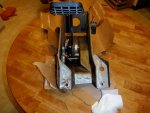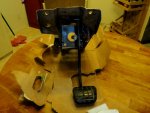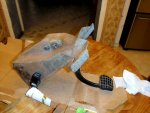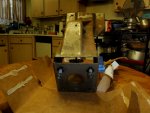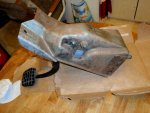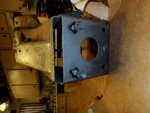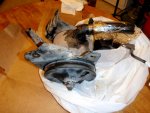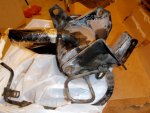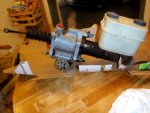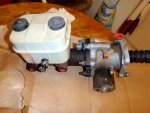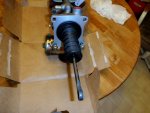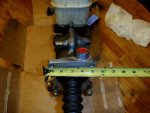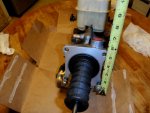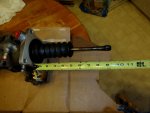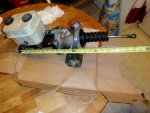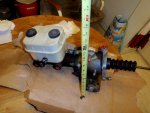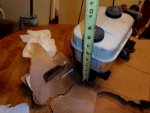tm america
Active member
- 2,600
- 25
- 38
- Location
- merrillville in
thats two brake res and one for the clutch hence the two pedals
Steel Soldiers now has a few new forums, read more about it at: New Munitions Forums!

Sounds like me replacing u-joints this weekend!driveline retarders!
no, actually you don't. there is an accumulator in almost all hydro-boost systems to give full braking power if pressure is lost. hydro-max incorporates a seperate electric pump.... i also like having power brakes to stop with even after the engine cut out and you loose that with hydro boost
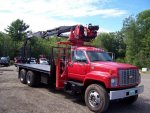
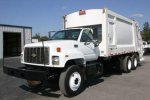
I'm going to try to do this while retaining the stock pedal assembly. I don't have a cab on my truck right now, so everything is very accessible. No big deal if it doesn't work, but I'm going to try.I think this system is easily adaptable to these trucks with the exception of the pedal assy. I originally mounted the hydroboost system under the truck nested up beside the transfer case. The Hydro-Max unit had a much larger (wider) reservoir so I firewall mounted it. Room was a little tight but it ended up fitting pretty well. Hood clearance is on the 'just barely' side but it does clear. Although these systems can and are installed with the booster and steering off of the same pump, the several trucks I had looked at with this had seperate pumps for steering and braking.
This is something that I'll definitely need to address, and I'm sure there's probably a simple way to do it, but I don't know much about air-brakes or the components used in those systems.Trailering...yes, I have thought about that and if it becomes something that I feel I will definately need, I'll get an air valve from a straight air brake truck and make some linkage to it.
A single way "conversion" like is described in the original post does not gain the redundancy of a dual circuit, even though there are two outlets.
A dual circuit for redundancy IMHO would be worth while if you are choosing to upgrade the brake system anyhow.
As far as mismatched numbers of wheel cylinders on each circuit, there is no discrepancy in the volume of fluid delivered versus required to any circuit (within some reasonable sizing limits, we're not talking about a Kia master cylinder here), a dual outlet master cylinder is self-compensating design. With a constant bore for the front and rear sections of the cylinder, It mechanically delivers a variable volume to each circuit as required to develop equal pressure in each circuit. at all times. The volume is needed to make the pressure, but the pressure is what stops the truck.
You guys are over thinking this...
There is no "proportioning" in this. None needed, none wanted. Equal pressure to all wheels gives "factory" proportioning. That's what you have now, that's what you want. A split master with equal bores front and rear inherently does this. Pressure in the front circuit will always equal the pressure in the rear circuit, even though the volumes are different. Until a failure, then you will have the pedal drop half way, and the mechanical stops will take over and allow the remaining undamaged brake circuit to function normally.
As far as a modern system...
Hydromaxx is a modern system. In OEM as produced trim on modern equipment, it delivers equal pressure to equal brake apparatus on each wheel, just as it should. This isn't a Ford Taurus, all the brakes have to pull their weight. The 70/30 thing that you hear about pretty much stops when you get beyond compact and a few mid sized sedans.
Everything you need for this system is done. All brakes of the same. No metering valve is used. All brakes require the same pressure to operate correctly. No proportioning valve is used. The differential valve if you choose to use it is contained within the master cylinder it's self. There are no other valves to add. If you're doing a disk/drum conversion, if you're adding bigger drum brakes to one axle but not the rest... Then yes you will need some external metering and proportioning, but for stock brakes, it's just a line to the chosen axle.
This is my poijnt. If you're going to do this, it'd be best not to have a failure of course, but if you do...
I would rather come to a complete stop in a straight line with no squeeling, skidding, or other unnecessary drama. That's what modern brake systems deliver, I just can't see why you would go to the extra effort to bypass that feature.
I must respectfully disagree with this. What you said is only true for a single circuit system because of Pascal's principle. It is also mostly true for 4 tire vehicles. And it also assumes the shoes are already tightly touching the drums (full lockup position). In that case I agree with you.
As far as I understand the brakes on this truck, all the wheel cylinders are identical, as are the shoes. Therefore, the cross sectional area of each wheel cylinder piston is identical. To obtain the same X throw of the wheel pistons, they must each receive the same volume of fluid. V=A*X
Having the same pressure at say full lockup for front and rear wheels means twice as much fluid went rear compared to front. Therein lies the dilemma with the 4 tire master cylinder. A single bore master cylinder with equal sized outputs will send equal volumes to each circuit. That will lock up the fronts & leave the rears free. You'll skid the fronts up to every stoplight. Most probably you will blow the front plunger in the master cylinder trying to stop.
Now, the friction associated with it will vary depending on what % of the truck's weight is over that particular wheel is a good point. But as someone already pointed out, with drum brakes you are supposed to adjust them all the same.
My guess is the volume problem is why the spicergear guy opted to put them back into one circuit.
Thanks for explaining this to us Jake. I was thinking like Unforgiven, and would have guessed that the rear axles would NOT see equal pressure in a dual-circuit system. Glad to be wrong in this case. More powerful AND safer? Sign me up. I'm glad to hear that I can switch over to dual-circuit brakes.You would be correct IF you took the master cylinder apart and welded all the parts together.
A dual outlet cylinder does not work like this. Volume is variable by design between the front or rear circuit. it does not matter if one circuit takes more. Neither builds pressure until both meet their volume demand (or reach the travel limit in the case of a blown line).
Here is a very good animation of how this works (Click the red arrow)
HowStuffWorks "How Master Cylinders and Combination Valves Work"
The friction won't vary at all with the weight, only the available traction. Yes they should all be adjusted the same, but again, the fluid volume available is variable.
Only he can answer that one. I wasn't there.
...i also like having power brakes to stop with even after the engine cut out and you loose that with hydro boost
I share tm america's concerns about the pedal effort required in a hydro-max system with no power, but that's a really good point mudguppy.no, actually you don't. there is an accumulator in almost all hydro-boost systems to give full braking power if pressure is lost. hydro-max incorporates a seperate electric pump.
also, it's a manual transmission - if you're rolling, then the engine is turning and the pump is making pressure.
Thanks for doing all that research, and for sharing what you found out with us.Okay,
I think I've found the most likely "compatible" master cylinder using the HydroMax boosting system.
It turn out that all of the fairly new Chevy Kodiak & GMC Topkicks up to the C7500 series use the HydroMax. Anything from 2000ish up should have it.
The C8500 used to use air brakes but are now hydraulic but not Hydromax.
I'll bet dollars to doughnuts that the HydroMax system from a C7500 Kodiac, tandem axle truck would fit perfectly (technically speaking-pressure, volume etc.) into the M35. I still need to look into the specs, but right now I'm thinking this is the best option.
View attachment 158871
View attachment 158872
Did you ever get into this project?Jake,
I can't guarantee flawless results. But here is what I plan to do. I will source out a 6x4 Hydromax. 6 meaning 6 wheels, 4 meaning 4 rear drive wheels (Kodiak doesn't come in 6x6 configuration)
I will then go to my flat, undisturbed patch of asphalt & run a few trials of say 50 to 0 stop times/distances.
Then I will convert over to Hydromax 6x4, assuming I source all the necessary parts by Jan.
Then I will go to the same location & perform several more full stops.
Then I will use the speed bleeds to simulate a front brake failure.
Then I will use the speed bleeds to simulate a rear brake failure.
I will post the results for those who are curious.
I cannot guarantee any success or any failures. All I can say is I will give it the old "college try" and see what happens.
From everything I have read, the stock wheel cylinders are good up to 1800 psi. The Hydromax MC is good up to 2000 psi. Maybe that's important, maybe it's not.
But I would prefer to adjust the brake pedal push to match the max psi, in this case 1800 just in case. I don't want to push more psi than the cylinders can handle.
I will try both powered down, clutch in w/engine running & powered down/w/o engine running clutch in trials.
If it is at least as strong as the stock system then I will call it a success. If it at least stops w/ front or rear then I will consider it an upgrade. If it is worse then I guess I rip it out & stick with the stock configuration.
I apologize to Mother Nature in advance for simulating a front/rear failure using speed bleeders & dumping 2-3 cubic inches of DOT 5 onto the asphalt.. It's all in the name of science.
Hope it helps.
I was going to do this, but I've since had a "design change" in what I hope to accomplish with the Deuce.Did you ever get into this project?

